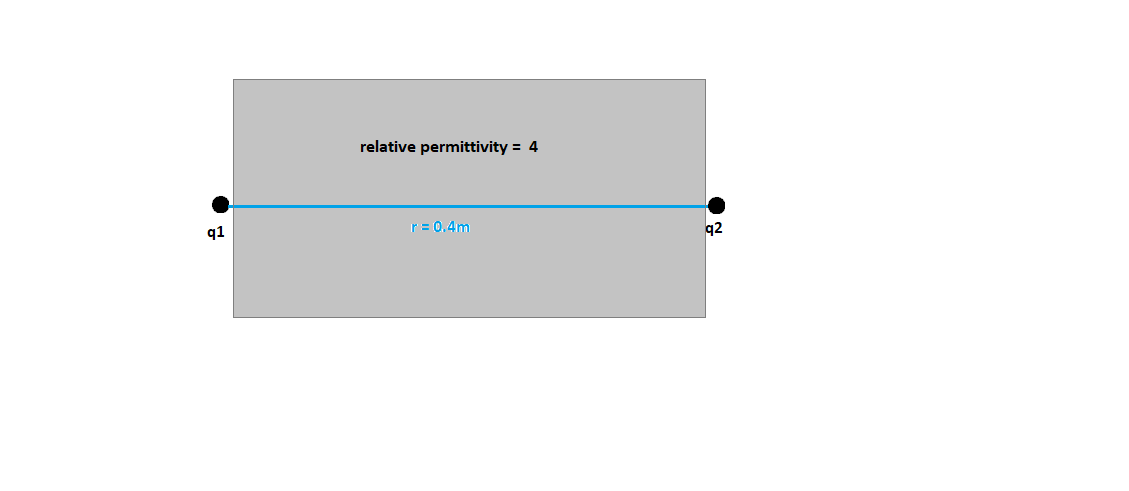
Calculate the force between two charges each of 20 microcoulombs in a medium of relative permittivity 4. The distance between the two charges is 40m.
Answer
567.9k+ views
Hint: The Coulombic force of attraction or repulsion between 2 charges depends upon the medium. If the medium is a dielectric, that has some polarisable properties then it cancels some of the permittivity of electric field lines through the medium. To account for this the Columba’s law equation is modified and a relative permittivity term is added for the dielectric. The modified Coulomb’s Law equation is given below.
Formula used:
\[F=\dfrac{{{q}_{1}}{{q}_{2}}}{4\pi {{\epsilon }_{0}}{{\epsilon }_{r}}{{r}^{2}}}\]
Complete answer:
The Coulombic force of attraction or repulsion between 2 charges depends upon the medium. If the medium is polarisable then the charges polarise the medium itself and that polarised medium then counters some of the force of attraction or repulsion between the charges. And thus cancels some of the permittivity of electric field lines through the medium. Thus in a dielectric medium a relative permittivity term is used to account for this effect and thus a modified Coulomb’s equation is used. In a medium of relative permittivity \[{{\epsilon }_{r}}\] the force of attraction between charges \[{{q}_{1}}\] and \[{{q}_{2}}\] separated by a distance r is given as
\[F=\dfrac{{{q}_{1}}{{q}_{2}}}{4\pi {{\epsilon }_{0}}{{\epsilon }_{r}}{{r}^{2}}}\]

Now coming to our question, Let's start by listing the known values
\[{{q}_{1}}={{q}_{2}}=20\times {{10}^{-6}}C\]
\[\begin{align}
& {{\epsilon }_{r}}=4 \\
& r=40cm \\
& \Rightarrow r=0.4m \\
\end{align}\]
Plugging in the given values in the equation we get
\[F=\dfrac{{{q}_{1}}{{q}_{2}}}{4\pi {{\epsilon }_{0}}{{\epsilon }_{r}}{{r}^{2}}}\]
\[\Rightarrow F=\dfrac{1}{4\pi {{\epsilon }_{0}}{{\epsilon }_{r}}}\times \dfrac{(20\times {{10}^{-6}})(20\times {{10}^{-6}})}{{{(0.4)}^{2}}}\]
We also know that
\[\dfrac{1}{4\pi {{\epsilon }_{0}}}=9\times {{10}^{9}}\]
Thus,
\[\begin{align}
& F=\dfrac{1}{4\pi {{\epsilon }_{0}}{{\epsilon }_{r}}}\times \dfrac{(20\times {{10}^{-6}})(20\times {{10}^{-6}})}{{{(0.4)}^{2}}} \\
& \Rightarrow F=\dfrac{9\times {{10}^{9}}}{4}\times \dfrac{400\times {{10}^{-12}}}{16\times {{10}^{-2}}} \\
& \Rightarrow F=\dfrac{9\times 4\times {{10}^{4}}\times {{10}^{-12}}\times {{10}^{9}}}{4\times 16} \\
& \Rightarrow F=5.625N \\
\end{align}\]
So, the force acting between the two charges will be \[5.625N\]
Note:
The \[{{\epsilon }_{0}}\] used the Coulomb’s Law formula \[F=\dfrac{1}{4\pi {{\epsilon }_{0}}}\times \dfrac{{{q}_{1}}\times {{q}_{2}}}{{{r}^{2}}}\] is called the permittivity of free space. It is basically the capability of a vacuum to permit electric field lines within it. This permittivity changes with the medium thus the \[{{\epsilon }_{r}}\] term is used for relative permittivity through a dielectric. It is called the dielectric constant or relative permittivity and it reduces the force acting between the charges.
Formula used:
\[F=\dfrac{{{q}_{1}}{{q}_{2}}}{4\pi {{\epsilon }_{0}}{{\epsilon }_{r}}{{r}^{2}}}\]
Complete answer:
The Coulombic force of attraction or repulsion between 2 charges depends upon the medium. If the medium is polarisable then the charges polarise the medium itself and that polarised medium then counters some of the force of attraction or repulsion between the charges. And thus cancels some of the permittivity of electric field lines through the medium. Thus in a dielectric medium a relative permittivity term is used to account for this effect and thus a modified Coulomb’s equation is used. In a medium of relative permittivity \[{{\epsilon }_{r}}\] the force of attraction between charges \[{{q}_{1}}\] and \[{{q}_{2}}\] separated by a distance r is given as
\[F=\dfrac{{{q}_{1}}{{q}_{2}}}{4\pi {{\epsilon }_{0}}{{\epsilon }_{r}}{{r}^{2}}}\]

Now coming to our question, Let's start by listing the known values
\[{{q}_{1}}={{q}_{2}}=20\times {{10}^{-6}}C\]
\[\begin{align}
& {{\epsilon }_{r}}=4 \\
& r=40cm \\
& \Rightarrow r=0.4m \\
\end{align}\]
Plugging in the given values in the equation we get
\[F=\dfrac{{{q}_{1}}{{q}_{2}}}{4\pi {{\epsilon }_{0}}{{\epsilon }_{r}}{{r}^{2}}}\]
\[\Rightarrow F=\dfrac{1}{4\pi {{\epsilon }_{0}}{{\epsilon }_{r}}}\times \dfrac{(20\times {{10}^{-6}})(20\times {{10}^{-6}})}{{{(0.4)}^{2}}}\]
We also know that
\[\dfrac{1}{4\pi {{\epsilon }_{0}}}=9\times {{10}^{9}}\]
Thus,
\[\begin{align}
& F=\dfrac{1}{4\pi {{\epsilon }_{0}}{{\epsilon }_{r}}}\times \dfrac{(20\times {{10}^{-6}})(20\times {{10}^{-6}})}{{{(0.4)}^{2}}} \\
& \Rightarrow F=\dfrac{9\times {{10}^{9}}}{4}\times \dfrac{400\times {{10}^{-12}}}{16\times {{10}^{-2}}} \\
& \Rightarrow F=\dfrac{9\times 4\times {{10}^{4}}\times {{10}^{-12}}\times {{10}^{9}}}{4\times 16} \\
& \Rightarrow F=5.625N \\
\end{align}\]
So, the force acting between the two charges will be \[5.625N\]
Note:
The \[{{\epsilon }_{0}}\] used the Coulomb’s Law formula \[F=\dfrac{1}{4\pi {{\epsilon }_{0}}}\times \dfrac{{{q}_{1}}\times {{q}_{2}}}{{{r}^{2}}}\] is called the permittivity of free space. It is basically the capability of a vacuum to permit electric field lines within it. This permittivity changes with the medium thus the \[{{\epsilon }_{r}}\] term is used for relative permittivity through a dielectric. It is called the dielectric constant or relative permittivity and it reduces the force acting between the charges.
Recently Updated Pages
Basicity of sulphurous acid and sulphuric acid are

Master Class 12 Business Studies: Engaging Questions & Answers for Success

Master Class 12 Economics: Engaging Questions & Answers for Success

Master Class 12 English: Engaging Questions & Answers for Success

Master Class 12 Maths: Engaging Questions & Answers for Success

Master Class 12 Social Science: Engaging Questions & Answers for Success

Trending doubts
What are the major means of transport Explain each class 12 social science CBSE

Which are the Top 10 Largest Countries of the World?

Draw a labelled sketch of the human eye class 12 physics CBSE

How much time does it take to bleed after eating p class 12 biology CBSE

Explain sex determination in humans with line diag class 12 biology CBSE

Differentiate between homogeneous and heterogeneous class 12 chemistry CBSE




